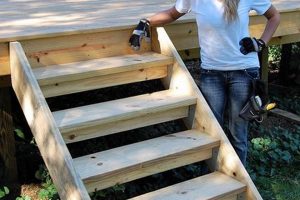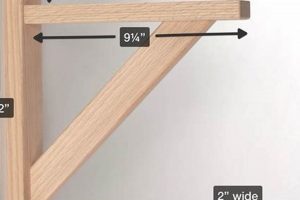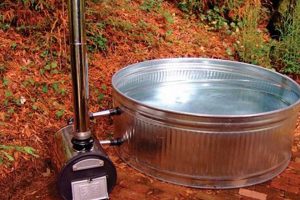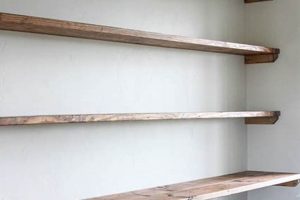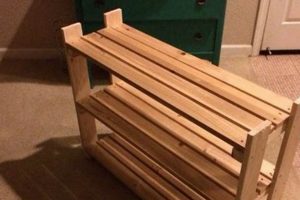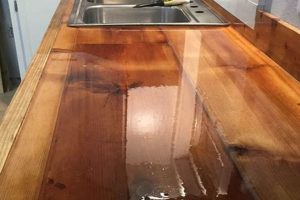A self-constructed receptacle for incoming mail, typically fashioned from lumber, provides a personalized alternative to mass-produced postal boxes. These home-built units offer diverse aesthetic possibilities and functional configurations. For example, an individual might construct a unit mimicking a miniature house or a simple, weather-resistant container with a hinged lid.
Creating a custom postal box offers significant advantages. It allows for precise dimensional control, ensuring capacity suited to individual needs. Furthermore, it permits the incorporation of stylistic elements reflecting personal preferences or complementing the architectural design of the associated property. Historically, handcrafted mail receptacles represented a common practice, reflecting a period when readily available, standardized options were limited.
The following sections will address essential considerations for planning, constructing, and maintaining a durable and aesthetically pleasing handcrafted postal box.
Essential Considerations for a Handcrafted Postal Box
The construction of a durable and functional postal box requires careful planning and execution. The following tips outline key considerations to ensure a successful project.
Tip 1: Material Selection: Choose weather-resistant lumber such as cedar, redwood, or treated pine to mitigate rot and insect damage. Consider the aesthetic appeal and ensure the material complements the surrounding environment.
Tip 2: Dimensional Planning: Adhere to United States Postal Service (USPS) regulations regarding size and placement. Research current guidelines to ensure compliance and avoid delivery complications. Internal dimensions should accommodate standard mail sizes without excessive crowding.
Tip 3: Construction Techniques: Employ robust joinery methods such as mortise and tenon, rabbet, or dovetail joints for enhanced structural integrity. Securely fasten components with exterior-grade screws and waterproof adhesive.
Tip 4: Weatherproofing: Apply multiple coats of exterior-grade paint or sealant to protect the lumber from moisture and ultraviolet radiation. Pay particular attention to seams and joints, where water ingress is most likely.
Tip 5: Flag Mechanism: If incorporating a signal flag, utilize durable hardware resistant to corrosion. Ensure the flag is prominently visible and easily manipulated to signal outgoing mail.
Tip 6: Post Mounting: Select a sturdy post material, such as pressure-treated lumber or metal, and securely anchor it in the ground. The post should be set deep enough to withstand wind loads and soil conditions.
Tip 7: Addressing: Clearly and legibly display the street address on both sides of the box. Use reflective lettering for enhanced visibility, particularly at night. Adhere to local regulations regarding address placement and size.
By adhering to these guidelines, the resulting unit will provide years of reliable service while enhancing curb appeal.
The subsequent section will address common issues encountered with these handcrafted units and recommended maintenance practices.
1. Wood Species Selection
The selection of appropriate wood species is paramount to the longevity and functionality of a self-constructed postal box. The chosen material directly impacts the structure’s resistance to environmental factors, its aesthetic appeal, and its overall service life.
- Weather Resistance
Different wood species exhibit varying degrees of resistance to moisture, sunlight, and temperature fluctuations. Cedar and redwood, for example, contain natural oils that deter insects and fungal growth, making them suitable for outdoor applications. Conversely, untreated pine is highly susceptible to rot and decay, necessitating extensive treatment for outdoor use.
- Durability and Strength
The structural integrity of the completed unit depends on the inherent strength of the wood species employed. Hardwoods, such as oak or maple, offer superior strength and impact resistance compared to softwoods like pine or fir. The selection should be aligned with the anticipated environmental stresses and potential physical impacts.
- Workability
Certain wood species are easier to work with, influencing the complexity of the project and the quality of the finished product. Softwoods are generally easier to cut, shape, and fasten than hardwoods. The selection should consider the builder’s skill level and the availability of appropriate tools. Denser woods, while more durable, may require specialized equipment for proper joinery.
- Aesthetic Qualities
The natural grain pattern, color, and texture of the selected wood species contribute significantly to the aesthetic appeal. Different wood types offer diverse visual characteristics, allowing for customization to complement the surrounding environment and reflect personal preferences. Careful consideration of these aesthetic properties is essential for achieving a visually pleasing and integrated outcome.
Ultimately, the optimal wood selection involves a trade-off between durability, workability, and aesthetics. Careful evaluation of these factors, in conjunction with the project’s specific requirements and environmental conditions, ensures the creation of a functional and aesthetically pleasing postal receptacle.
2. Structural Joint Strength
The longevity and utility of a wooden postal box are directly proportional to the strength of its joints. Insufficient joint strength leads to premature failure, rendering the structure unable to withstand environmental stressors such as wind, rain, and temperature fluctuations. For example, a box constructed with weakly glued butt joints may separate at the seams after repeated exposure to moisture, compromising its weather resistance and structural integrity.
Robust joint construction is not merely an aesthetic consideration; it is a critical component of the box’s overall functionality. Techniques such as mortise and tenon, dovetail, or rabbet joints, secured with appropriate adhesives and fasteners, distribute stress more effectively than simple butt joints. Consider a unit subjected to high winds; a box with properly executed mortise and tenon joints will maintain its form and function, whereas a box with weaker joints is likely to deform or collapse. Proper joinery also ensures the box maintains its rectangular shape, which helps with the opening and closing of any door hardware, or makes for less likely wood fatigue/wear from warping.
In summary, prioritizing joint strength during construction is paramount. The selection of appropriate joinery techniques and materials, coupled with meticulous execution, directly influences the durability, weather resistance, and overall lifespan of the wooden postal box. Neglecting this aspect results in a fragile structure susceptible to damage, necessitating frequent repairs or replacement, thus negating the cost and effort invested in its creation.
3. USPS Compliance
The United States Postal Service (USPS) establishes specific regulations regarding the design, dimensions, and placement of mail receptacles to ensure efficient and safe mail delivery. Adherence to these regulations is essential when constructing a handcrafted postal box to avoid service interruptions or rejection of mail.
- Size and Dimensions
USPS guidelines dictate minimum and maximum dimensions for postal boxes to accommodate standard mail volumes. These requirements ensure that letter carriers can deposit mail without damage or obstruction. Failure to adhere to these dimensions may result in mail being left exposed to the elements or returned to sender. For instance, a box that is too small may cause letters and packages to be bent or folded, while an excessively large box may present logistical challenges for carriers.
- Placement and Accessibility
USPS regulations specify the acceptable height and location of the postal box relative to the street or access point. These guidelines aim to ensure easy and safe access for letter carriers, minimizing potential hazards or delays during delivery. Non-compliant placement, such as a box positioned too far from the road or obstructed by vegetation, may result in the suspension of mail service.
- Identification and Addressing
USPS requires that the postal box be clearly and legibly marked with the recipient’s address, including street number and name. Proper identification is essential for accurate mail delivery and prevents misdelivery or loss of correspondence. The address should be displayed in a manner that is easily visible to letter carriers, even in low-light conditions. Reflective lettering or numbering is often recommended for enhanced visibility.
- Flag Regulations (if applicable)
If the handcrafted unit incorporates a signal flag to indicate outgoing mail, adherence to USPS guidelines regarding its size, placement, and functionality is critical. The flag must be easily visible to letter carriers and positioned in a manner that does not obstruct access to the box. Non-compliant flag designs or placements may be overlooked by carriers, resulting in delayed mail pickup.
Compliance with USPS regulations is an integral aspect of designing and constructing a functional and reliable handcrafted postal box. By adhering to these guidelines, builders can ensure uninterrupted mail service and avoid potential complications with their local postal delivery.
4. Weather Resistance
Weather resistance is a critical attribute of any successful “diy wooden mailbox”. The primary function of a postal box is to protect its contents from environmental elements. Therefore, a self-constructed unit’s long-term viability directly depends on its ability to withstand rain, snow, intense sunlight, and temperature fluctuations. Inadequate weather resistance leads to deterioration of the lumber, compromising structural integrity and ultimately resulting in mail damage or loss. For example, a box constructed from untreated pine and exposed to prolonged periods of rain will likely exhibit warping, rot, and eventual collapse, rendering it unusable.
The selection of appropriate materials and construction techniques is paramount in achieving adequate weather resistance. Wood species naturally resistant to decay, such as cedar or redwood, offer inherent protection. Furthermore, the application of exterior-grade sealants, paints, or stains provides an additional barrier against moisture penetration and ultraviolet radiation damage. Proper joint construction, employing techniques that minimize water ingress, is also crucial. Consider the design of the lid; an overhanging lid provides a degree of protection against rain, preventing water from directly entering the box. Ignoring these aspects can lead to costly repairs or premature replacement of the entire unit.
In conclusion, weather resistance is not merely a desirable feature but a fundamental requirement for any functional “diy wooden mailbox”. Careful material selection, robust construction techniques, and appropriate protective coatings are essential to ensure longevity and protection of mail contents. Addressing weather resistance proactively minimizes maintenance and ensures the sustained utility of the self-constructed postal box.
5. Aesthetic Integration
Aesthetic integration represents a significant consideration in the design and construction of a handcrafted postal box. The visual harmony between the structure and its surrounding environment enhances curb appeal and reflects the homeowner’s personal style, transforming a utilitarian object into a complementary element of the property.
- Architectural Style Concordance
The design of the postal box should align with the architectural style of the residence. A contemporary home may benefit from a minimalist box with clean lines, while a Victorian-era house could be complemented by a more ornate design featuring decorative moldings and detailing. A disjunction in style can create a jarring visual effect, detracting from the overall aesthetic of the property.
- Material and Color Harmony
The materials and colors used in the construction of the postal box should harmonize with existing landscape and building elements. Selecting lumber that complements the siding or trim of the house and using paint colors that coordinate with the overall color scheme contributes to a cohesive aesthetic. Contrasting colors can be employed strategically to create visual interest, but care must be taken to ensure the contrast remains complementary.
- Landscape Integration
The postal box can be integrated into the landscape design through the incorporation of plants, flowers, or decorative stone. Surrounding the structure with complementary foliage or incorporating it into a small garden bed enhances its visual appeal and creates a sense of unity with the surrounding environment. Consider how the seasons will affect the surrounding landscape and choose plants that will complement the box year-round.
- Scale and Proportion
The size and proportions of the postal box should be appropriate for the scale of the house and the surrounding landscape. An excessively large box may overwhelm a small property, while an undersized box may appear insignificant. Careful consideration of these factors ensures that the structure is visually balanced and complements its surroundings.
Therefore, aesthetic integration is paramount when crafting a “diy wooden mailbox”. Harmonizing the structure with its environment elevates it beyond a mere functional item, contributing to the overall visual appeal and property value. Neglecting this aspect can result in a structure that appears out of place and detracts from the aesthetic qualities of the home.
Frequently Asked Questions
The following addresses common inquiries regarding the design, construction, and maintenance of self-built lumber postal receptacles.
Question 1: What are the primary advantages of constructing a wooden postal box compared to purchasing a prefabricated metal unit?
Handcrafted units afford greater customization in terms of dimensions, materials, and aesthetic design. This enables tailoring the receptacle to specific needs and preferences, as well as ensuring integration with the surrounding architectural style.
Question 2: Which wood species are most suitable for withstanding exposure to the elements?
Weather-resistant lumber, such as cedar, redwood, or treated pine, are recommended. These species exhibit natural resistance to rot, insect infestation, and moisture damage, extending the lifespan of the structure.
Question 3: What are the key United States Postal Service (USPS) regulations that must be observed during construction?
USPS guidelines pertain to the dimensions, placement, and accessibility of postal receptacles. Adherence to these regulations is essential for ensuring mail delivery and avoiding potential service disruptions. It is important to consult the latest USPS Publication 28, Postal Construction Standards.
Question 4: What are the recommended techniques for ensuring structural integrity and preventing premature failure?
Employing robust joinery methods, such as mortise and tenon, rabbet, or dovetail joints, is crucial. Securely fastening components with exterior-grade screws and waterproof adhesive further enhances structural stability. Proper anchoring of the support post is also important.
Question 5: What maintenance practices are recommended to prolong the lifespan of a wooden postal box?
Periodic inspection for signs of rot, insect damage, or paint deterioration is advised. Applying fresh coats of exterior-grade paint or sealant helps protect the lumber from environmental degradation. Clearing debris from the interior and ensuring proper drainage are also beneficial.
Question 6: How can the structure be effectively integrated into the existing landscape and architectural design?
Selecting materials and colors that complement the surrounding environment is essential. Incorporating design elements that echo the architectural style of the residence further enhances visual harmony. Landscape features such as plants or decorative stone can be used to integrate the structure into the existing surroundings.
In summary, careful planning, appropriate material selection, adherence to regulations, and consistent maintenance are critical for ensuring the longevity and functionality of a DIY lumber postal box.
The following section will discuss potential design variations and aesthetic customization options for “diy wooden mailbox”.
In Conclusion
This exploration has underscored that the construction of a “diy wooden mailbox” involves a multifaceted process demanding attention to structural integrity, regulatory compliance, aesthetic coherence, and long-term durability. The selection of appropriate materials, the implementation of robust joinery techniques, and adherence to USPS guidelines are paramount to the creation of a functional and enduring structure.
The commitment to these principles ensures not only a functional receptacle for mail but also an enhancement to property aesthetics, reflecting individual craftsmanship and dedication to detail. The enduring value lies in the fusion of utility and personal expression, a testament to the enduring appeal of self-sufficiency and thoughtful design.


